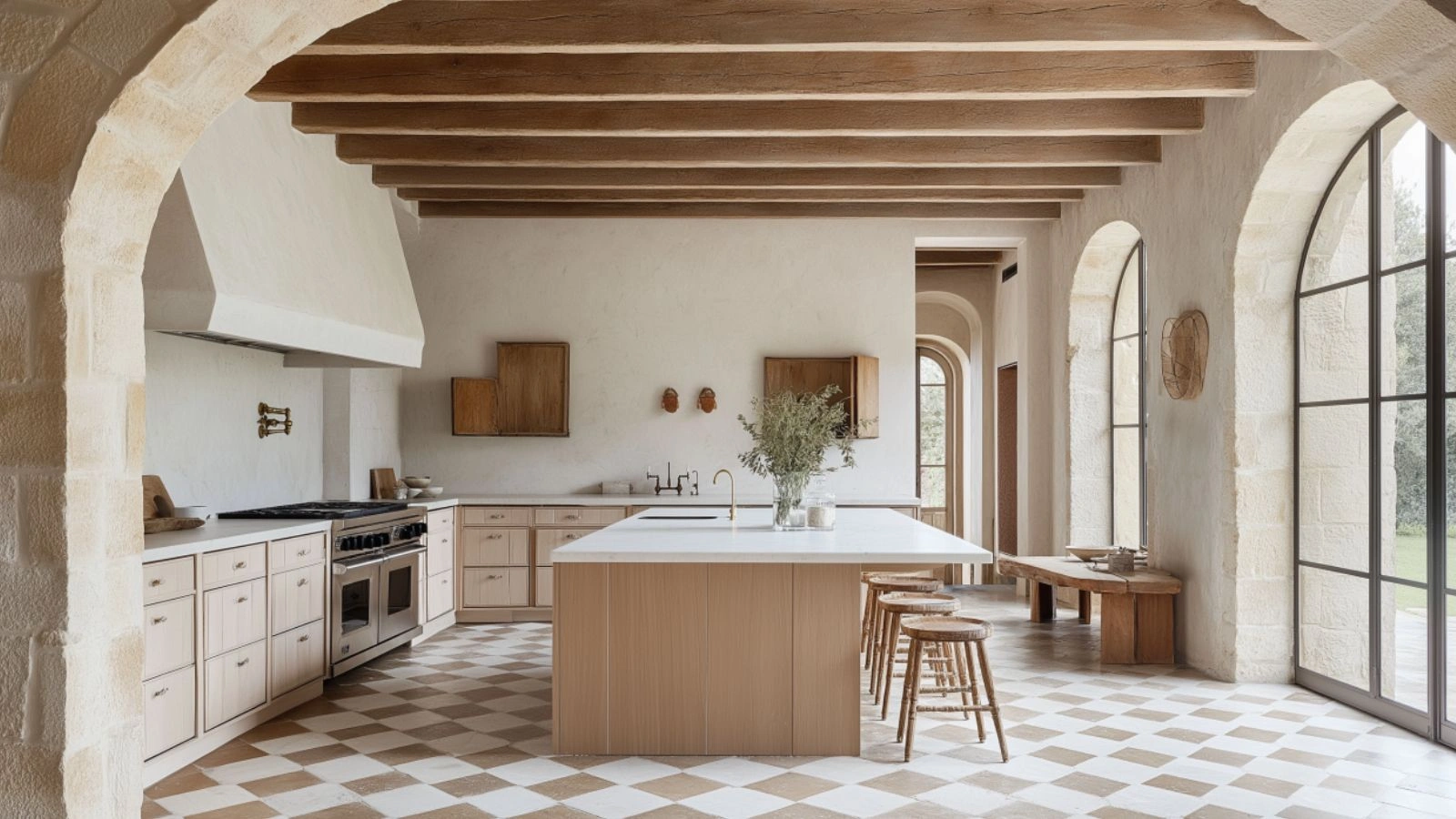Modern French Chateau Kitchen with Antique Touches for Timeless Elegance
Table of Contents
A kitchen is the heart of the home, and when it’s styled as a modern French chateau, it becomes more than just functional—it becomes an experience. French kitchens are renowned for their timeless charm, rustic textures, and layered elegance. But today’s design trends have taken this old-world romance and infused it with fresh, modern sensibilities.
Blending modern conveniences with antique touches creates a space that feels luxurious yet lived-in, refined yet warm. Think marble countertops paired with vintage brass faucets, streamlined cabinetry softened by aged oak beams, or high-end appliances wrapped in traditional-style paneling. This fusion of new and old transforms the kitchen into a space that honors craftsmanship, storytelling, and intentional design.
In this guide, you’ll explore how to design a modern French chateau kitchen with antique influences. We’ll cover cabinetry, flooring, lighting, architectural elements, hardware, and finishes—each designed to capture that effortless Paris-meets-Provence elegance. Whether you’re doing a full kitchen renovation or just planning a subtle update, these ideas will help you achieve a look that’s sophisticated, functional, and timeless.
Architectural Details That Set the Tone
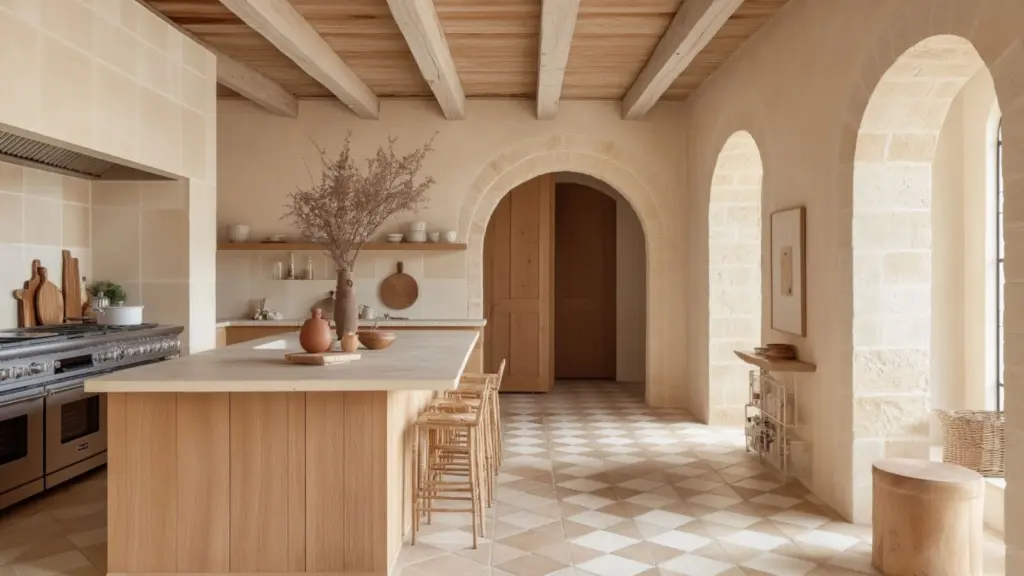
Every great French chateau kitchen begins with architectural features that create structure and drama. From coffered ceilings to stone archways, these details lay the foundation for the entire aesthetic.
Exposed ceiling beams, for example, are a classic hallmark of rustic French style. Even faux beams can introduce warmth and dimension when painted in a soft whitewash or left natural to contrast against smooth walls. Arched doorways or oversized range hoods clad in plaster also speak to the grandeur of old European estates.
Wainscoting or panel molding on walls adds textural interest while maintaining formality. For flooring, consider large-format limestone tiles, reclaimed wood, or checkerboard patterns in neutral tones to ground the space.
Table: Architectural Elements for French Chateau Flair
| Feature | Description | Design Tip |
|---|---|---|
| Exposed beams | Wood beams on ceiling (real or faux) | Leave natural or whitewashed for softness |
| Arched openings | Stone or plaster archways | Ideal for connecting kitchen to dining |
| Statement hood | Oversized range hood in plaster or wood | Center above range as focal point |
| Checkerboard floors | Black/white or tan/cream stone tiles | Use matte finishes for aged feel |
Antique-Inspired Cabinetry for a Refined Touch
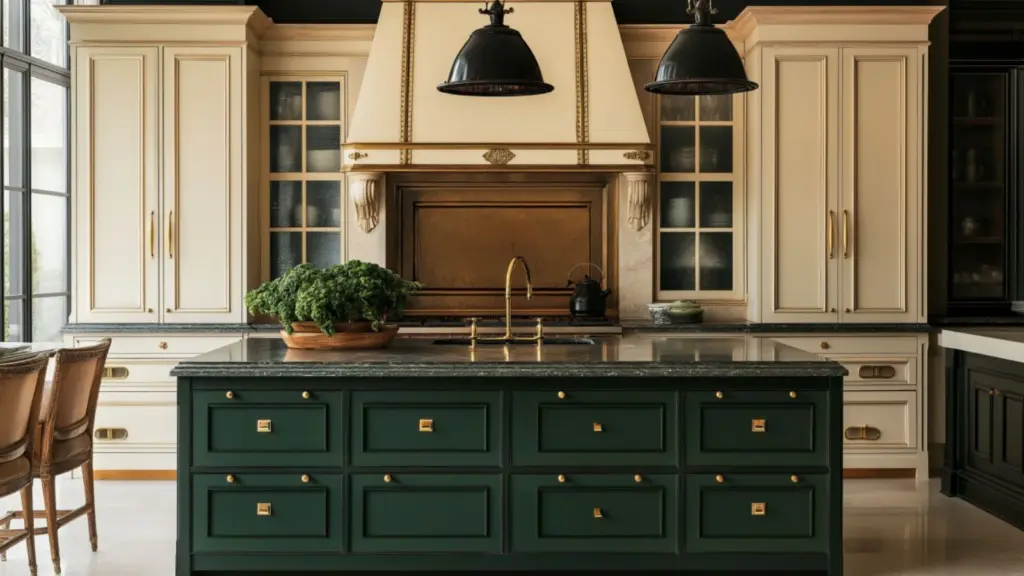
Cabinetry in a modern French chateau kitchen should balance sophistication and lived-in warmth. Think inset cabinet doors, raised panels, and brushed finishes that feel artisanal rather than mass-produced.
For a traditional base, opt for cream, taupe, or soft greige tones. If you want contrast, a deep navy or forest green island works beautifully. Cabinet finishes should feel rich—matte paints, distressed woods, and subtly aged glazes help capture that antique charm.
Don’t forget decorative details like corbels, crown molding, or furniture-style legs. Glass-front upper cabinets, especially with vintage-inspired mullions, bring an open and airy feel to the upper space.
Table: Cabinet Styles and Finishes for Antique Appeal
| Cabinet Style | Finish/Detail | Complementary Features |
|---|---|---|
| Inset shaker | Matte paint in cream or linen | Aged brass hardware, beaded trim |
| Raised panel | Light distressing | Marble countertops, antique pulls |
| Glass-front | Mullion design with seeded glass | Decorative dishware, ceramic vases |
| Custom island base | Furniture feet, contrasting tone | Butcher block or honed stone top |
Stone Countertops and Backsplashes That Exude Elegance
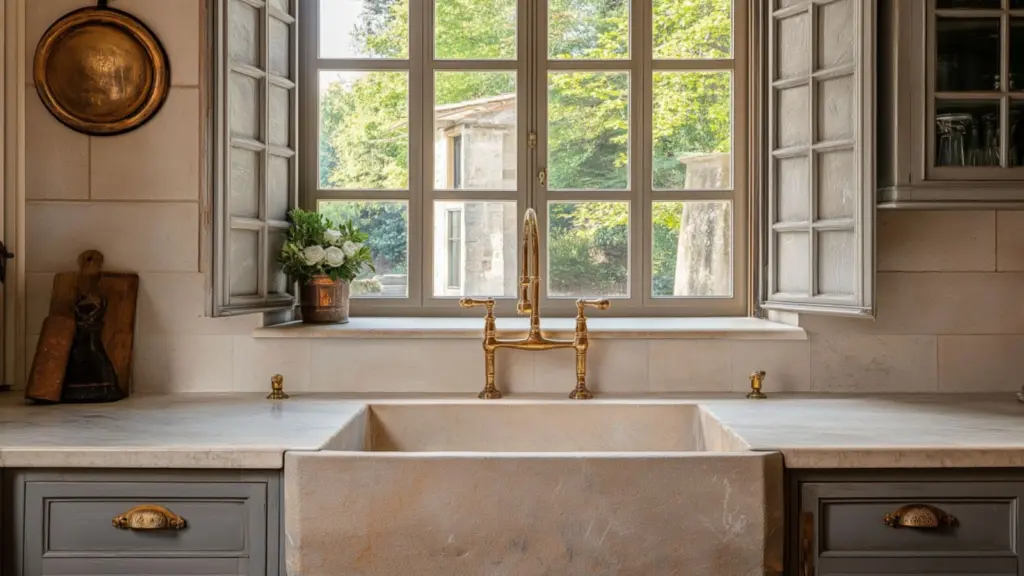
In a French-style kitchen, stone surfaces play a vital role in adding authenticity and refinement. Choose materials with subtle veining, matte finishes, or a weathered look to enhance the antique-inspired elements.
Marble is a perennial favorite, especially honed Calacatta or Carrara for a soft, romantic touch. If you’re concerned about durability, consider quartz alternatives in similar finishes. For backsplashes, full slab marble adds drama, while handmade ceramic tiles or tumbled travertine provide a more rustic, countryside effect.
Table: Stone and Tile Combinations for the French Chateau Look
| Surface Area | Material Choice | Look Achieved |
|---|---|---|
| Countertops | Honed marble or quartz | Soft elegance with natural veining |
| Backsplash | Zellige or travertine tile | Subtle texture, artisanal feel |
| Island surface | Butcher block or soapstone | Contrast with visual warmth |
| Wall detail | Full slab stone | Seamless and luxurious backdrop |
Lighting Fixtures That Blend Old and New
Lighting in a modern French chateau kitchen should feel like curated jewelry—elegant, purposeful, and slightly romantic. Avoid overly modern lines or industrial metals in favor of aged brass, wrought iron, or antique-finished fixtures.
A chandelier above the island or breakfast table adds drama and a traditional flourish. For task lighting, go with wall-mounted sconces, hanging lanterns, or bell-shaped glass pendants. If you want a more modern touch, choose a refined silhouette in a time-worn finish.
Table: Lighting Options for a French-Inspired Kitchen
| Fixture Type | Ideal Placement | Style Features |
|---|---|---|
| Wrought iron chandelier | Over kitchen island | Curved arms, candle-style bulbs |
| Aged brass pendants | Above sink or workstations | Vintage glass or classic dome shapes |
| Wall sconces | Near open shelves or hood | Swing arm or tapered linen shades |
| Lantern lights | Entry or side wall | Glass panels with distressed metal frame |
Mixing Metals and Hardware for Timeless Detail
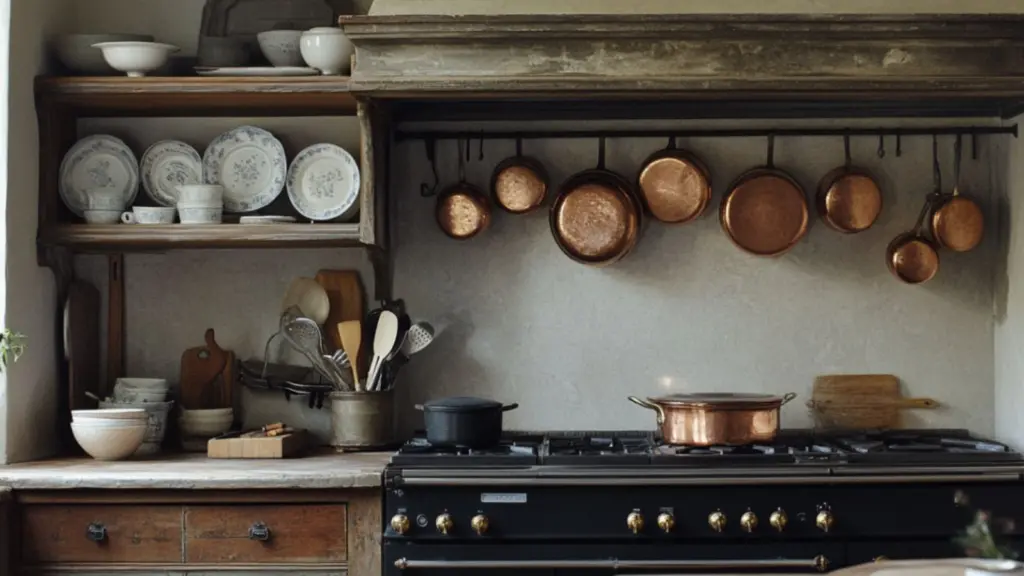
One of the defining features of a French chateau kitchen is the mix of metals that feels collected over time. Brushed brass, antique bronze, and pewter are all ideal choices. Rather than matching every metal, layer finishes thoughtfully for a more nuanced look.
Use one dominant finish (like unlacquered brass) for faucets and hardware, and introduce a secondary tone (such as wrought iron) in lighting or decor. Knobs and pulls with curved profiles, backplates, or patina contribute to the vintage aesthetic.
Table: Mixed Metal Pairing Guide for Cohesive Design
| Metal Type | Where to Use It | Works Well With |
|---|---|---|
| Unlacquered brass | Faucet, drawer pulls | Aged nickel, cream cabinetry |
| Aged bronze | Lighting fixtures | Warm woods, marble countertops |
| Antique pewter | Shelf brackets, dish racks | Matte black or brushed steel appliances |
| Wrought iron | Cabinet knobs or barstools | Stone surfaces, rustic beams |
Furniture and Decor to Finish the Space with Character
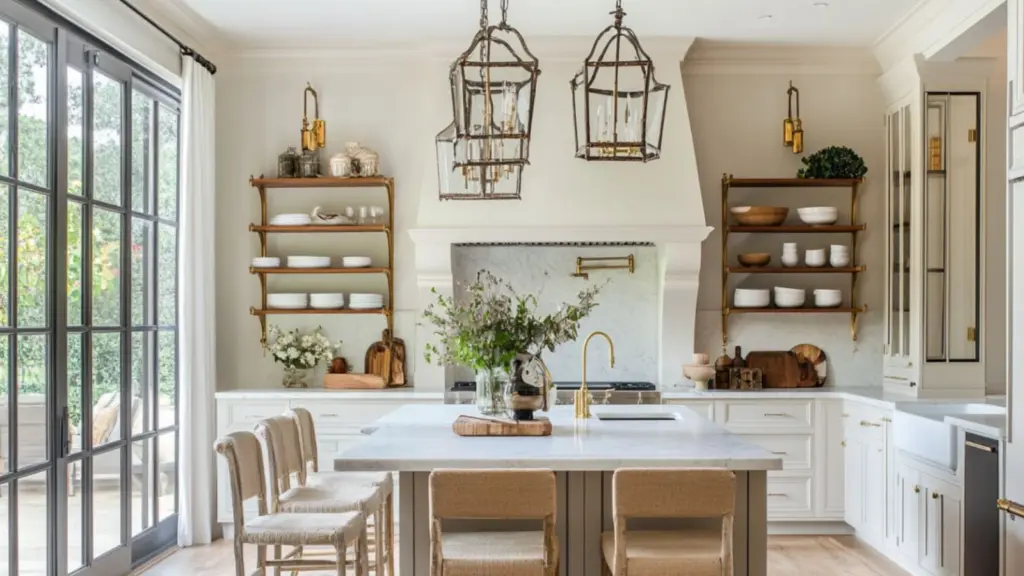
French kitchens often feel like an extension of the living space, so furniture and decor should add warmth and familiarity. Add a freestanding hutch or open shelving unit styled with ceramics, cookbooks, or baskets. Include upholstered counter stools in linen or velvet for soft elegance.
Decor should feel intentional: a vase of fresh herbs, a stack of vintage breadboards, or a copper pot on display. Incorporate French market finds like wire baskets, terracotta planters, or blue-and-white porcelain to elevate authenticity.
Table: Styling Elements for a Lived-In, Elegant Kitchen
| Decor Item | Placement | Purpose |
|---|---|---|
| French breadboards | Leaning against backsplash | Adds texture and history |
| Herb bouquets | In ceramic or glass vase | Fresh, fragrant, seasonal accent |
| Copper cookware | Displayed on hooks or shelves | Functional and beautiful |
| Linen textiles | Draped over sink or open shelves | Adds softness and casual elegance |
Conclusion
A modern French chateau kitchen with antique touches is a beautiful marriage of form and function, refinement and comfort. By layering architectural elements, tactile finishes, curated metals, and timeworn accents, you can create a space that feels luxurious yet grounded, updated yet timeless.
Whether you’re doing a full renovation or simply layering in new finishes and decor, each thoughtful detail adds depth and story. The charm of a French kitchen doesn’t come from trend—it comes from the balance of old-world soul and modern sensibility, creating a kitchen that’s as welcoming as it is exquisite.

